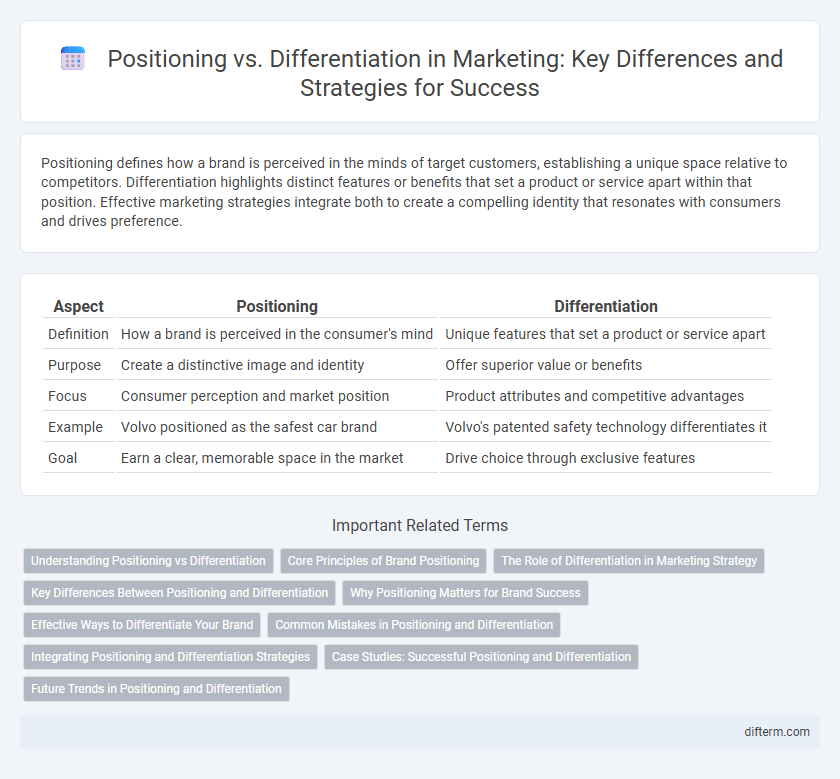Positioning defines how a brand is perceived in the minds of target customers, establishing a unique space relative to competitors. Differentiation highlights distinct features or benefits that set a product or service apart within that position. Effective marketing strategies integrate both to create a compelling identity that resonates with consumers and drives preference.
Table of Comparison
| Aspect | Positioning | Differentiation |
|---|---|---|
| Definition | How a brand is perceived in the consumer's mind | Unique features that set a product or service apart |
| Purpose | Create a distinctive image and identity | Offer superior value or benefits |
| Focus | Consumer perception and market position | Product attributes and competitive advantages |
| Example | Volvo positioned as the safest car brand | Volvo's patented safety technology differentiates it |
| Goal | Earn a clear, memorable space in the market | Drive choice through exclusive features |
Understanding Positioning vs Differentiation
Positioning defines how a brand is perceived in the minds of target customers, emphasizing specific attributes or benefits that align with market needs. Differentiation focuses on creating unique product features or brand qualities that set a business apart from competitors. Understanding positioning versus differentiation helps marketers craft strategies that effectively communicate value and competitive advantage.
Core Principles of Brand Positioning
Brand positioning emphasizes creating a distinct image in the consumer's mind by targeting specific needs and values that align with the brand's identity. Core principles include clarity, consistency, and credibility, ensuring the brand message resonates and builds trust over time. Differentiation supports positioning by highlighting unique features and benefits that set the brand apart from competitors within the chosen market segment.
The Role of Differentiation in Marketing Strategy
Differentiation plays a critical role in marketing strategy by creating unique value propositions that distinguish a brand from competitors and attract target customers. Unlike positioning, which defines the brand's place in the market, differentiation emphasizes distinct product features, quality, or customer service that competitors cannot easily replicate. Effective differentiation drives customer loyalty, supports premium pricing, and enhances brand equity by clearly communicating why consumers should choose one brand over another.
Key Differences Between Positioning and Differentiation
Positioning defines how a brand is perceived in the minds of target customers, emphasizing its unique value and market niche. Differentiation involves developing distinct features or attributes that set a product or service apart from competitors. Key differences lie in positioning focusing on customer perception and market placement, while differentiation centers on tangible product benefits and innovation.
Why Positioning Matters for Brand Success
Positioning defines how a brand is perceived in the minds of target customers, shaping its unique value proposition and emotional appeal. Effective positioning creates a clear, memorable identity that distinguishes a brand from competitors, driving customer loyalty and market share growth. Brands that master positioning align their marketing strategies to resonate deeply with consumer needs and preferences, ensuring sustained brand success.
Effective Ways to Differentiate Your Brand
Effective ways to differentiate your brand include emphasizing unique value propositions that resonate with target customers and leveraging innovative features or superior quality not offered by competitors. Positioning should communicate a clear, distinct identity based on these differentiators to create strong brand recognition and loyalty. Consistent messaging across all channels reinforces differentiation, making the brand memorable and preferred in a crowded market.
Common Mistakes in Positioning and Differentiation
Common mistakes in positioning include targeting overly broad audiences and failing to clearly communicate unique value, resulting in weak brand identity. In differentiation, businesses often imitate competitors rather than highlighting true distinct advantages, which diminishes competitive edge. Misalignment between positioning and differentiation strategies further confuses customers and reduces overall market effectiveness.
Integrating Positioning and Differentiation Strategies
Integrating positioning and differentiation strategies enables brands to establish a unique market identity while clearly communicating distinct value propositions. Effective positioning defines the target audience's perception, setting the foundation for differentiation through product features, customer experience, or innovation. Combining these strategies enhances competitive advantage, fosters customer loyalty, and drives sustainable growth in dynamic market environments.
Case Studies: Successful Positioning and Differentiation
Case studies reveal that successful positioning hinges on clearly defining a brand's unique value proposition within a competitive landscape, such as Apple's emphasis on innovation and user experience in the tech market. Differentiation strategies exemplified by Tesla leverage cutting-edge electric vehicle technology and sustainability credentials to stand out in the automotive industry. Together, these approaches drive consumer preference and create strong brand loyalty through tailored messaging and distinctive product attributes.
Future Trends in Positioning and Differentiation
Future trends in positioning and differentiation emphasize hyper-personalization, leveraging AI-driven data analytics to tailor marketing strategies and create unique consumer experiences. Brands increasingly focus on sustainability and ethical practices as key differentiators, aligning with evolving consumer values and regulatory standards. The integration of immersive technologies, such as augmented reality and virtual reality, enhances brand storytelling and deepens emotional connections, transforming market positioning in competitive landscapes.
Positioning vs Differentiation Infographic

 difterm.com
difterm.com